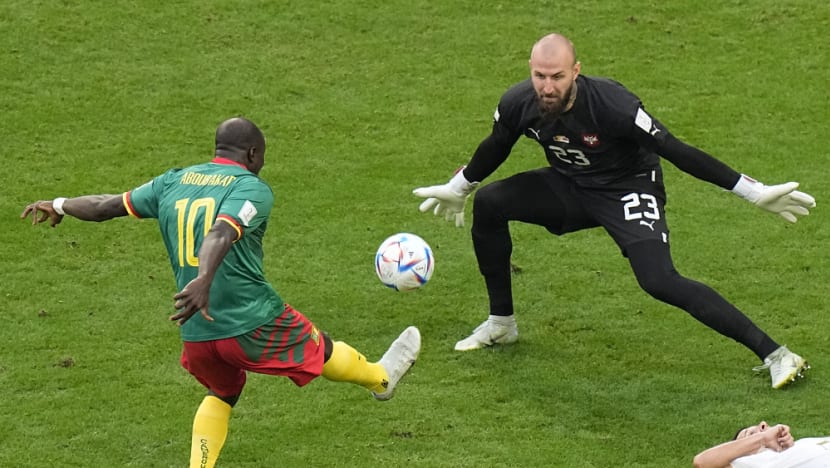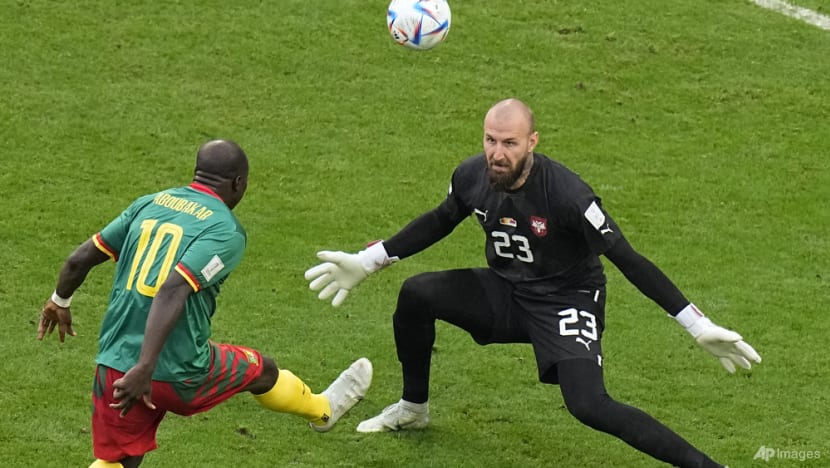Commentary: Football’s VAR is a lesson in flawed technology
Robot linesmen are no substitute for the real thing and offer a warning against using inventions for their own sake says Financial Times’ John Thornhill.

Cameroon's Vincent Aboubakar, 10, reacts as he scores side's second goal during the World Cup group G soccer match between Cameroon and Serbia, at the Al Janoub Stadium, Qatar, Nov 28, 2022. (AP Photo/Manu Fernandez)
LONDON: When the Cameroonian striker Vincent Aboubakar extravagantly scooped the football over the head of the Serbian goalkeeper into the back of the net, he thought he was offside. More importantly, so did the linesman.
Aboubakar’s celebrations only kicked off when the video assistant referee suggested otherwise, helping Cameroon stage a thrilling comeback in their World Cup match in Qatar on Monday (Nov 28).
Before the introduction of the video assistant referee (VAR), Aboubakar’s goal would not have been allowed. Had it been in operation in Mexico in 1986, VAR would surely have ruled out Diego Maradona’s infamous “hand of God” goal against England, when the Argentine punched the ball over the line.



On such decisions, made and unmade, hang footballing destinies, national mythologies and the emotions of millions of sports fans around the world.
At the latest World Cup, the football has been engrossing. But the matches should also interest anyone involved in designing or delivering a technology service.
DIFFICULT TO GET VAR RIGHT
The use of video assistance technology provides an intriguing case study of how difficult it can be to achieve optimal product-market fit in a highly pressured environment that matters hugely to millions of fanatical followers.
Technology may well deliver increased accuracy, but at what cost? Traditionalists complain that VAR has put the sport’s values at risk by wasting time, undermining the agency of on-field referees and adding new, and different, dimensions of controversy.
The use of VAR was first codified in football’s official laws in 2018 and the technology was rolled out at the world cup in Russia later that year.
Off-field referees monitoring multiple video feeds were made responsible for identifying “clear and obvious” mistakes and “serious missed incidents” when it came to awarding goals and penalties, issuing red cards and confirming the identity of players who had been sanctioned.
The evidence showed that VAR did indeed increase the accuracy of decision making. On average, a referee makes 137 observable decisions during an international football match, most of which are now reviewed in near real time.
At the World Cup in Russia, the international football association FIFA found that of the 455 incidents checked by VAR across the tournament, referees made the correct final calls in 99.4 per cent of cases, compared with 95.6 per cent without its use.
One consequence was that referees spotted more infringements, awarding 29 penalties (including nine as a result of VAR checks) compared with 13 at the previous World Cup in Brazil. But the use of VAR also prolonged the length of matches: The average time for reviewing an incident was 82 seconds.
Since then, VAR has been adopted by many football leagues around the world. But critics still argue that it has added more confusion than clarity. Few resist objective factual checks as to whether a football crosses the goal line or a player is offside, for example.
But there is more controversy over subjective decisions, such as awarding a penalty or a red card when the on-field referee is asked to review their original decision. Holding decisions to a higher standard means they can cause even more outrage when fans believe they are wrong.
LESSONS TO BE DRAWN FROM USING VAR
There are perhaps two lessons to be drawn from the use of VAR, applicable to the adoption of many other decision-making systems.
First, technology should never be used just for technology’s sake. It should only ever be deployed in clear and limited situations where it can demonstrably improve the process, to inform a human expert’s decision, not replace it.
But efficiency also matters. In trying to solve one set of problems, technology should not create new ones. Systems should constantly be improved in response to feedback.
To that end, it is vital that users –and fans – understand how the system works and trust the methodology. Black box systems are rarely a good idea. In that sense, video officials at cricket matches do a better job of showing the evidence to viewers and explaining how they reach their decisions.
Ensuring that decisions can be explained is as crucial for VAR as it is for artificial intelligence systems, now widely used in many areas such as finance, healthcare and law.
The principle behind VAR of “minimum interference, maximum benefit” is a good one. But experience demonstrates how difficult that is to implement in real life.
As maths teachers insist, show your workings when solving any problem. VAR’s decision-making processes should themselves be reviewed.
Catch free highlights and moments from the FIFA World Cup Qatar 2022™ at mewatch.sg/fifaworldcup.















